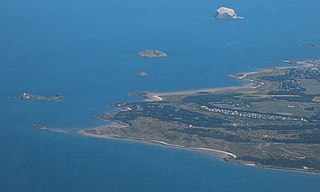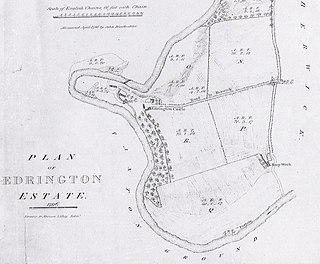
The Bass Rock, or simply the Bass, is an island in the outer part of the Firth of Forth in the east of Scotland. Approximately 2 kilometres (1 mi) offshore, and 5 kilometres (3 mi) north-east of North Berwick, it is a steep-sided volcanic rock, 107 metres (351 ft) at its highest point, and is home to a large colony of gannets. The rock is uninhabited, but historically has been settled by an early Christian hermit, and later was the site of an important castle, which after the Commonwealth period was used as a prison. The island belongs to Sir Hew Hamilton-Dalrymple, whose family acquired it in 1706, and before to the Lauder family for almost six centuries. The Bass Rock Lighthouse was constructed on the rock in 1902, and the remains of an ancient chapel survive.

Esquire is usually a courtesy title.

The former Royal Burgh of Lauder is a town in the Scottish Borders in the historic county of Berwickshire. On the Southern Upland Way, the burgh lies 27 miles (43 km) southeast of Edinburgh, on the western edge of the Lammermuir Hills.

Kirriemuir, sometimes called Kirrie, is a burgh in Angus, Scotland. Its history reaches back to earliest recorded times, when it is thought to have been a major ecclesiastical centre. Later it was identified with witchcraft, and some older houses still feature a "witches stane" to ward off evil. In the 19th century, it was an important centre of the jute trade. The playwright J. M. Barrie was born and buried here, and a statue of Peter Pan stands in the town square.
Sir Robert Lauder of the Bass was a Scottish knight, armiger, and Governor of the Castle at Berwick-upon-Tweed. He was also a member of the old Scottish Parliament. The Lauders held the feudal barony of The Bass, East Lothian, Edrington Castle and lands in the parish of Mordington, Berwickshire, Tyninghame in Haddingtonshire, and numerous other estates and properties elsewhere in Scotland.

Berwick Castle is a ruined castle in Berwick-upon-Tweed, Northumberland, England.

Dirleton is a village and parish in East Lothian, Scotland approximately 20 miles (32 km) east of Edinburgh on the A198. It contains 7,500 acres (30 km2). Dirleton lies between North Berwick (east), Gullane (west), Fenton Barns (south) and the Yellowcraigs nature reserve, Archerfield Estate and the Firth of Forth (north). Gullane parish was joined to Dirleton parish in 1612 by an Act of Parliament because "Golyn is ane decaying toun, and Dirleton is ane thriven place."

Stenton is a parish and village in East Lothian, Scotland. It is bounded on the north by parts of the parishes of Prestonkirk and Dunbar, on the east by Spott and on the west by Whittingehame. The name is said to be of Saxon derivation. The village has a number of houses, a school, and a church.

Edrington is a medieval estate occupying the lower part of Mordington parish in Berwickshire, Scottish Borders, Scotland, five miles (8.0 km) west of Berwick-upon-Tweed. From probably the 14th century, if not earlier, a castle occupied the steep hill above the mill of the same name on the Whiteadder Water. The castle ruin is still marked on today's Ordnance Survey maps, and still appears in locality references in The Berwickshire News. The principal farm of the estate is Edrington Mains.
There has been one baronetcy granted to the Lauder family. The baronetcy of Lauder of Fountainhall, Haddingtonshire, was created for John Lauder, last surviving male representative of the Lauders of that Ilk, a rich merchant-burgess and sometime Treasurer and baillie of the City of Edinburgh, and an armiger. He purchased the estate of Newington, Edinburgh, and subsequently the lands of Woodhead and Templehall near Pencaitland, which along with others in Edinburghshire and Haddingtonshire, were erected by Crown charter into the feudal barony of Fountainhall on 13 August 1681.

Morham, East Lothian, sometimes spelt Moram, Morum, or Morhame in old records, is the smallest (agricultural) parish in Scotland, sandwiched between five other parishes: Haddington, Garvald, Yester, Whittingehame, and Prestonkirk, in the undulating lower reaches of the Lammermuir Hills.
Sir John Bellenden of Auchnole and Broughton was, before 1544, Director of Chancery, and was appointed Lord Justice Clerk on 25 June 1547, succeeding his father Thomas Bellenden of Auchnoule. John was knighted before April 1544.

Garvald is a village south-east of Haddington in East Lothian, Scotland. It lies on the Papana Water south of the B6370, east of Gifford. The combined parish of Garvald and Bara, borders Whittingehame to the East, Morham to the North, Yester to the West, and Lauder to the South. It is mainly an agricultural parish. The red freestone once constantly mined in this parish was well known throughout the whole country.
Sir George Lauder of the Bass, Knight, was a cleric, Privy Counsellor, and Member of the Scottish Parliament. He was also Tutor to Henry Frederick, Prince of Wales.
Robert Lauder of The Bass was an important noble in Haddingtonshire, Berwickshire, and Fife. Stodart remarks that "to 1600 the barons of the Bass sat in almost every parliament". He was a firm supporter of Mary, Queen of Scots whom he accompanied to Carberry Hill on 14 June 1567, and fought for at the battle of Langside.
Sir Robert Lauder of Popill Knt. was a Member of the old Scottish Parliament and an adherent of Mary, Queen of Scots.
John Sinclair was an Ordinary Lord and later Lord President in the Court of Session. He married Mary, Queen of Scots to Lord Darnley.

Sir Thomas Lauder Brunton, 1st Baronet, was a Scottish physician who is most-closely associated with the use of amyl nitrite to treat angina pectoris.

Sir Robert Lauder of Beilmouth, Knt., was an armiger, lawyer and Clerk of Exchequer in Scotland. In 1683 he was made a Justice of the Peace for Haddingtonshire. As Robert Lauder of Belhaven he was in the old Scottish parliament for Haddington in 1685, and, as Sir Robert Lauder of Beilmouth, in 1704. He was also Commissioner of Supply for Haddington in 1689 and 1690.
Sir Robert de Lawedre (Lauder) of Edrington & The Bass, Knt., was a Burgess of Edinburgh and a confidant of King Robert III and sometime Guardian of his son, the future James I of Scotland.











